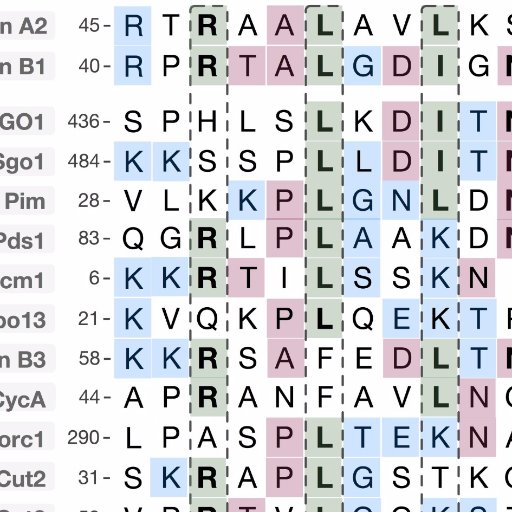
Short Linear Motif team
@DaveyLab
Followers
567
Following
9
Media
6
Statuses
91
SLiM propagandists Migrating to @slim-team.bsky.social
London, England
Joined June 2014
SIMBA, a novel quantitative intracellular peptide binding assay, is now on BioRxiv. It excels at saturation mutagenesis studies to define SLiM-binding determinants. This collaboration with the Pryciak group at UMass is the first of many, so keep a look out
biorxiv.org
Transient protein-protein interactions play key roles in controlling dynamic cellular responses. Many examples involve globular protein domains that bind to peptide sequences known as Short Linear...
0
0
4
Congratulations to @IfigeniaT42 and Iza on the publication of CompariPSSM - a PSSM–PSSM comparison tool for motif-binding determinant analysis. This part of Ifigenia's her recently completed PhD work and her first first author paper. Check it out here:
academic.oup.com
AbstractMotivation. Short linear motifs (SLiMs) are compact functional modules that mediate low-affinity protein–protein interactions. SLiMs direct the fun
0
1
4
Have you ever wondered how many of the human SLiMs are required for cell viability? We mutated them all to find out in another extremely fun collaboration with the @NilssonLabCph group. The results are now on bioRxiv https://t.co/UKttv5D4su. Check it out!
biorxiv.org
Short linear motifs (SLiMs) are the most ubiquitous protein interaction modules in the unstructured regions of the human proteome. Despite their central role in protein function, our understanding of...
0
11
26
Great collaboration with the @DaveyLab on defining short linear motifs required for cell fitness using base editor screens. Hundreds of novel functional SLiMs to explore! A proteome-wide dependency map of protein interaction motifs
biorxiv.org
Short linear motifs (SLiMs) are the most ubiquitous protein interaction modules in the unstructured regions of the human proteome. Despite their central role in protein function, our understanding of...
1
20
56
Excited to present a new docking motif for IKK (Inhibitor of κB (IκB) kinase)! A great collaboration with the Zanier lab at the ESBS showed a YDDΦxΦ motif in IκBα, IκBβ and p100 recruits IKK. https://t.co/zfGZ0Q528W
0
4
15
Hazem's FaSTPACE paper is out, a novel tool for rapid peptide alignment and motif extraction! It's fast enough to tackle 1000s of peptides - just what's needed to tackle the recent explosion in high-throughput peptide discovery methods. Read here:
academic.oup.com
Abstract. Several novel high-throughput experimental techniques have been developed in recent years that generate large datasets of putative biologically f
1
3
7
Our new paper with the @Ivarssonlab & @NilssonLabCph teams characterising mutations in intrinsically disordered regions on a proteome-wide scale! We show numerous examples of disease-causing SNVs making and breaking SLiMs in work driven by Johanna Kliche.
embopress.org
imageimageHundreds of mutations in the intrinsically disordered regions of the human proteome that break, diminish, enhance or create motif-based interactions are uncovered by mutational proteomic...
0
4
21
There's an associated database to make it easier to explore the data. Check it out here https://t.co/dWPMkrT6T7
0
2
8
Our work on protein/phosphorylation abundance changes through the cell cycle is on bioRxiv. Very much an ICR Division of Cancer Biology project (Thanks to @jc4_jyoti @MansfeldLab @PinesLab teams). All pushed to completion by Camilla, Ifigenia and Theo.
biorxiv.org
The cell cycle governs a precise series of molecular events, regulated by coordinated changes in protein and phosphorylation abundance, that culminates in the generation of two daughter cells. Here,...
1
9
21
Cool work from @duxin_lab on Pol Kappa. Happy that my lab together with @DaveyLab could contribute with base editing screening in cells. Catalytic and non-catalytic functions of DNA polymerase kappa in translesion DNA synthesis
biorxiv.org
Translesion DNA synthesis (TLS) is an essential process that allows cells to bypass lesions encountered during DNA replication and is emerging as a primary target of chemotherapy. Among vertebrate...
0
3
19
We have an open PhD position applying mass spectrometry-based approaches to peptide interactomics for motif discovery. It's an exciting interdisciplinary project with the Choudhary lab for someone with a strong computational background. Details here:
1
8
8
Latest screen exploring how #disease-associated #SNVs in IDRs affect SLiM-based #protein-protein #interactions is now up on bioRxiv. Another fun collaboration with the @Ivarssonlab/@NilssonLabCph labs driven by the amazing team of Johanna and Leandro.
0
0
6
The servers are all back online after their little summer holiday. Everything has been upgraded and there may be a few issues so let us know if you see anything odd.
0
0
8
Our resources (ProViz, PSSMSearch, SLiMSearch, xProtCAS, etc) will be down for a couple of days for updates to the server. Sorry if anyone is in need of some summer motif hunting. But hopefully most of you are on holidays.
0
0
6
Minimum Information About Disorder Experiments (MIADE) guidelines provide community recommendations on the minimum information that should be reported with experiments that structurally characterize intrinsically disordered proteins or regions. @DaveyLab
https://t.co/rtN3uALnF6
nature.com
Nature Methods - This Perspective introduces the Minimum Information About Disorder Experiments guidelines, which provide a community consensus on the minimum information required to appropriately...
0
13
24
Time to get the disordered protein field a bit more ordered! We propose guidelines on how to describe IDP experiments to better serve experimental researchers, computational biologists, and database/method developers. This was a fun community wide effort led by @DaveyLab
A third of all known proteins are either completely or partially unstructured. EMBL scientists contributed to MIADE, a new set of guidelines that will help researchers share data on such proteins in a more useful way & enable machine learning analyses. https://t.co/JDLWrE1Yxv
0
3
9
There has been a revolution in the complexity of the experiments characterising the structural properties of IDRs. This revolution has not been reflected by advances in the data standardisation of the field. Now is the time to put those foundational concepts in place.
0
0
4
The idea is simple. The growing understanding of the significance of IDRs by researchers outside the IDP field has increased the importance of making high quality, unambiguous and understandable IDP data accessible to the wider community.
1
0
3
The MIADE paper defining minimum information guidelines for the structural IDP field is out today in @naturemethods. I'm so thankful to the MIADE team, @_BalintMeszaros, Kim, @NPalopoli, Fede, Andras and Eduardo, for helping push the project to completion.
1
7
21










